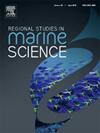Spatial-temporal distribution and polymer characterization of microplastics in surface waters of Lake Singkarak (Solok Region, Indonesia): A baseline study
IF 2.4
4区 环境科学与生态学
Q3 ECOLOGY
引用次数: 0
Abstract
Microplastics (MPs) are emerging pollutants of global concern, yet their distribution in tropical freshwater ecosystems remains poorly understood. This study presents the first comprehensive assessment of MP occurrence in the surface waters of Lake Singkarak, a nationally strategic ecosystem and habitat for endemic fish species. Surface water samples were collected from five monitoring stations (S1–S5) during both rainy and dry seasons. MPs were widely distributed across all stations, with average concentrations ranging from 250 to 1200 particles L⁻¹ , and abundance was generally higher during the rainy season, particularly at sites influenced by domestic activities, aquaculture, and agriculture. Station S2 (Muaro Paninggahan) exhibited the highest seasonal increase (≈1000 %), while stations with minimal anthropogenic influence (S4 and S5) showed comparatively smaller variations (28–67 %). Fragments dominated MP morphology, and polyamide (PA) and polyethylene terephthalate (PET) were the most frequently detected polymers, suggesting significant contributions from domestic waste, aquaculture operations, and agricultural runoff. Although spatiotemporal variations were apparent, statistical analyses indicated no significant seasonal differences (p > 0.05), highlighting the influence of localized environmental factors, such as hydrodynamics and human activity, on MP distribution. These findings underscore the urgent need for targeted pollution control, improved waste management, and long-term monitoring to safeguard the ecological integrity and socio-economic value of Lake Singkarak.
印尼Singkarak湖(Solok地区)地表水中微塑料的时空分布和聚合物特征:基线研究
微塑料(MPs)是全球关注的新兴污染物,但它们在热带淡水生态系统中的分布仍然知之甚少。本研究首次全面评估了辛卡拉克湖地表水MP的发生情况,辛卡拉克湖是国家战略生态系统和特有鱼类栖息地。5个监测站(S1-S5)在雨季和旱季采集地表水样本。MPs广泛分布在所有站点,平均浓度在250到1200个L -⁻¹ 之间,在雨季丰度普遍较高,特别是在受家庭活动、水产养殖和农业影响的站点。S2站(Muaro Paninggahan)的季节增幅最大(≈1000 %),而人为影响最小的站(S4和S5)的季节增幅相对较小(28-67 %)。碎片主导了MP形态,聚酰胺(PA)和聚对苯二甲酸乙二醇酯(PET)是最常检测到的聚合物,表明生活垃圾、水产养殖作业和农业径流对其有重要贡献。虽然时空变化明显,但统计分析显示没有显著的季节差异(p >; 0.05),突出了局部环境因素(如水动力和人类活动)对MP分布的影响。这些发现强调,迫切需要有针对性的污染控制、改善废物管理和长期监测,以保护辛卡拉克湖的生态完整性和社会经济价值。
本文章由计算机程序翻译,如有差异,请以英文原文为准。
求助全文
约1分钟内获得全文
求助全文
来源期刊

Regional Studies in Marine Science
Agricultural and Biological Sciences-Ecology, Evolution, Behavior and Systematics
CiteScore
3.90
自引率
4.80%
发文量
336
审稿时长
69 days
期刊介绍:
REGIONAL STUDIES IN MARINE SCIENCE will publish scientifically sound papers on regional aspects of maritime and marine resources in estuaries, coastal zones, continental shelf, the seas and oceans.
 求助内容:
求助内容: 应助结果提醒方式:
应助结果提醒方式:


